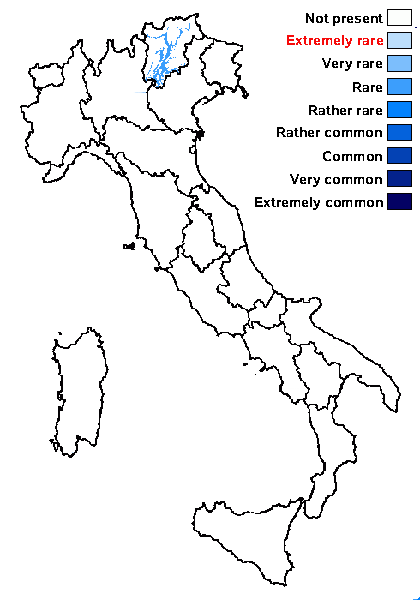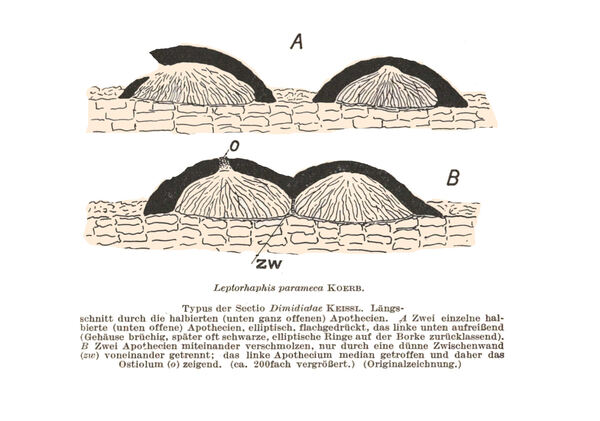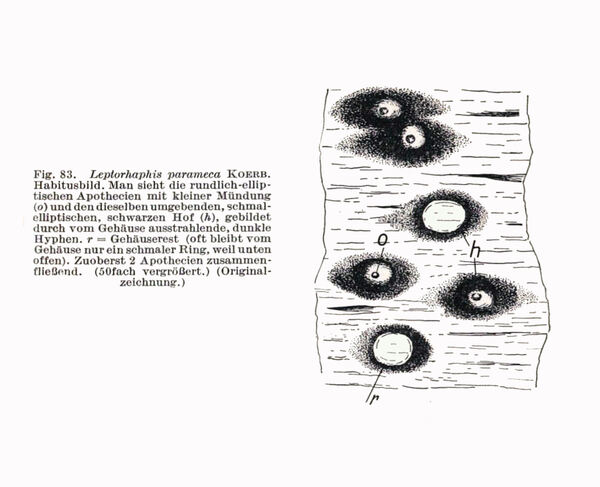Leptorhaphis parameca (A. Massal.) Körb.
Parerga Lichenol.: 368, 1865. Basionym: Sagedia parameca A. Massal. - Symmicta Lich.: 97, 1855.
Synonyms: Leptorhaphis xylographoides Norman; Spermatodium paramecum (A. Massal.) Trevis.; Verrucaria parameca (A. Massal.) Stizenb.
Distribution: N - Ven (Lazzarin 2000b), TAA (Nascimbene & al. 2007b).
Description: Thallus inapparent, doubtfully lichenized, consisting of dark brown to greenish black hyphae. Perithecia black, shiny, (0.15-)0.3-0.4(-0.6) mm across, ellipsoid, at first immersed, then hemispherical to flattened and c. 0.1 mm high, the central ostiole sometimes located in a small depression. Involucrellum greenish black, c. 15-18 μm thick, extending beyond the perithecium in a distinct, 170-300 μm wide basal fringe composed of pieces of bark intermixed with greenish-black hyphae; exciple thin, poorly evident, pale throughout; pseudoparaphyses 2-2.5(-3) μm thick; hymenial gel I+ pale blue. Asci 8-spored, cylindrical-clavate, bi- and fissitunicate, with a broad, truncate apical beak. Ascospores 1-septate, hyaline, narrowly fusiform, arcuate or sigmoid, 30-46 x 2-4 μm. Photobiont absent. Spot tests: K-, C-, KC-, P-, UV-. Chemistry: without lichen substances.
Note: a non-lichenized saprobe mostly growing on Prunus.
Growth form: Fungus
Substrata: bark
Reproductive strategy: mainly sexual
Pioneer species
Commonnes-rarity: (info)
Alpine belt: absent
Subalpine belt: absent
Oromediterranean belt: absent
Montane belt: absent
Submediterranean belt: rare
Padanian area: absent
Humid submediterranean belt: absent
Humid mediterranean belt: absent
Dry mediterranean belt: absent

Predictive model
Herbarium samples
Growth form: Fungus
Substrata: bark
Reproductive strategy: mainly sexual
Pioneer species
Commonnes-rarity: (info)
Alpine belt: absent
Subalpine belt: absent
Oromediterranean belt: absent
Montane belt: absent
Submediterranean belt: rare
Padanian area: absent
Humid submediterranean belt: absent
Humid mediterranean belt: absent
Dry mediterranean belt: absent

Predictive model
| Herbarium samples |
 INDEX FUNGORUM
INDEX FUNGORUM
 GBIF
GBIF
 DOLICHENS
DOLICHENS



